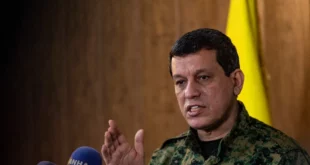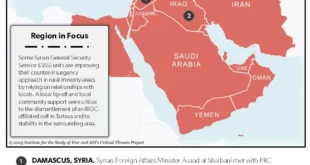Sitting down to write my annual assessment on trends in terrorism in early 2025, I am struggling more than usual, fresh off the horrors of an Islamic State (ISIS)-inspired terrorist attack in New Orleans that killed fourteen people and injured dozens more. It is always a challenge to look beyond the immediate, to take a step back and weigh myriad factors and variables that impact which trends may accelerate and which may disappear.
It is impossible to know whether the New Orleans attack suggests a “new wave” of ISIS-inspired attacks in the West and in the United States in particular. Rather, the attack is another data point that demonstrates what many in the counterterrorism community have been saying ad nauseum for years—the threat posed by ISIS is consistent, enduring, and likely to ebb and flow over time in response to geopolitical events and counterterrorism pressure. Still, the threat is enduring and will remain an uncomfortable truth for policymakers as they attempt to right-size the resources provided to counter-terrorism agencies with their agreed-upon level of risk tolerance.
Predicting when and where terrorists will strike is among the most difficult tasks an intelligence analyst has. This requires assessing the combination of capabilities, intent, and operational environment, overlayed with public statements and propaganda of terrorist groups to understand their grievances and discern possible target selection.
Terrorism does not always proceed in a linear fashion. In other words, sometimes what seem to be the most obvious or pressing threats fail to materialize, while others that appear to have faded reemerge again. Before the Hamas attacks of October 7, 2023, few counterterrorism analysts outside of Israel dedicated any bandwidth to analyzing the group. And before Hayat Tahrir al-Sham’s (HTS) December offensive that saw the group topple longtime dictator Bashar al-Assad and seize control of Syria, the organization was something of an afterthought, outside of a small circle of committed scholars and experts.
As HTS looks to assume power in Syria, disaffected hardliners within the group, including jihadists belonging to the Turkestan Islamic Party and other Central Asian battalions, could seek to splinter off and continue their violent campaign. Both Syria and Afghanistan are now governed by terrorist groups (HTS is formally designated as a foreign terrorist organization by the United States, while the Taliban is not, although elements of the Taliban are designated through their affiliation with the Haqqani Network).
So, while Hamas and HTS were mostly under the radar, the group that many were most concerned about—Islamic State Khorasan, or ISIS-K—also launched several high-profile attacks (Iran in January 2024 and Russia in March 2024) while a flurry of plots was disrupted, including a plan to attack a Taylor Swift concert in Vienna, Austria over the summer. The perpetrators in the Swift plot were extremely young, reflecting another trend—youth radicalization—that remains a constant challenge for counterterrorism authorities.
ISIS attacks in Dagestan and Oman showed the group’s geographic expanse, a trend likely to continue in the coming year as it seeks to resurge from Syria to Somalia. The group inspired a plot to attack the United States on Election Day in November. Nasir Ahmad Tawhedi was arrested by the FBI before he was able to put his plan into action, in which he intended to murder civilians with AK-47 rifles.
The ISIS-K presence in Afghanistan, which the Taliban has failed to attenuate, will continue to destabilize South Asia, where militant groups including Tehrik-i-Taliban Pakistan and the Baluchistan Liberation Army also remain growing threats to monitor. The former has directly threatened the government in Islamabad while the latter continues to target Chinese nationals and disrupt security along Beijing’s signature foreign policy initiative, the Belt and Road infrastructure project.
Sub-Saharan Africa, especially the Sahel region, will continue to be a hotbed of terrorism, as failed states and ungoverned spaces provide sanctuary to a range of jihadist groups associated with both al-Qaeda and the Islamic State. Jama’at Nasr al-Islam wal-Muslimin operates with near impunity in Western Africa, even conducting a massive attack last year that killed more than 600 people in Burkina Faso. The security situation continues to deteriorate as jihadist groups push out toward coastal West Africa, threatening previously stable countries like Ghana and expanding their reach from Cameroon to Nigeria.
Along with Burkina Faso, Niger and Mali have employed private military contractors from Russia’s Wagner Group (now rebranded as Africa Corps) to help with coup-proofing, and the mercenaries have behaved predictably, engineering a scorched earth counterinsurgency approach that has exacerbated the terrorist threat, rather than mollifying it. Elsewhere in Africa, both al-Shabaab and ISIS threaten Somalia and the greater Horn of Africa, while the Islamic State’s presence has ebbed and flowed in Mozambique and the Democratic Republic of Congo, among other states in the region.
The incessant reverberations of October 7th and the collapse of the Assad regime mean that geopolitical events in the Middle East will still be a significant driver of terrorism this year.
Lebanese Hezbollah has been attenuated to a degree many could not have imagined just one year ago. Israel’s devastating pager and walkie-talkie attack in September left the group reeling, killing more than a dozen and injuring thousands more. As the centerpiece of a relentless military campaign in Lebanon, the Israel Defense Forces assassinated Hezbollah Secretary General Hassan Nasrallah in September.
While Hezbollah has no doubt been severely degraded, the group remains dangerous and could seek to revert to its roots as a purely terrorist organization. The last time Israel killed a Hezbollah leader, as occurred with Abbas al-Musawi in 1992, the group responded by launching bombing attacks against Israeli targets in Buenos Aires, Argentina. Its global network remains intact, and in the past, it has demonstrated reach with attacks in Panama, Saudi Arabia, and Bulgaria and plots disrupted in Cyprus, Egypt, and Singapore. Hezbollah could look to strike US and/or Israeli interests, including embassies, in countries throughout Latin America, Africa, or elsewhere based on perceived security vulnerabilities.
Like Hezbollah, Hamas has also been crippled. Israel’s scorched earth approach in Gaza and the resulting humanitarian catastrophe—45,000 Palestinians have been killed so far—will make it easier for Hamas to recruit the next generation of militants. Hamas will also look to spread its influence in the West Bank. But the group’s capabilities will be limited for the foreseeable future. Still, even if Hamas remains limited in Gaza, the conflict itself has spilled across borders and catalyzed protests, demonstrations, and acts of violence abroad, including in Europe, North America, and Australia.
If Hamas decided to do so, it could likely leverage pro-Palestinian sentiment and anti-Israeli grievances to inspire attacks in the West among its supporters or these individuals could take action on their own. This could take many forms, including attacks or plots to attack Israeli embassies or consulates, as occurred in Serbia in June and almost occurred against the Israeli Consulate in New York City in December. Following the attacks of October 7th, there has been a massive spike in both Islamophobia and anti-Semitism globally, with spillover impacting many Western countries.
Of all the proxies belonging to Iran’s so-called “Axis of Resistance,” the Houthis in Yemen may be the most difficult to deter. The United States, United Kingdom, and Israel have all taken turns bombing Houthi positions in an effort to blunt the group’s ability to launch attacks and disrupt commercial shipping in the Red Sea. Between the Houthis, which the Trump administration will seek to redesignate as a foreign terrorist organization, and an array of Iraqi Shia militia groups, including Kataib Hezbollah and Harakat al-Nujaba, elements of the Axis present an omnipresent threat in the Middle East.
Upon scanning the horizon, looking ahead it seems plausible that a terrorist group will seek to command the spotlight through a spectacular attack, which could feature the use of an emerging technology like drones, 3-D printing, or involve the use of a weapon of mass destruction. The more lethal or high-profile an attack, the more prestige it garners, and the more mileage an individual or group can get out of propaganda geared toward supporters, followers, and potential new recruits.
There is also a growing trend in cooperation between terrorist groups, including the case of the Houthis working with al-Shabaab in Somalia, and al-Qaeda in the Arabian Peninsula expanding cooperation with the Houthis. There is also a state sponsorship element present, with both Russia and China assisting the Houthis with targeting data and weapons, respectively.
With President-elect Donald Trump taking office in just a few weeks, there are a host of other terrorism-related issues to consider. The Trump administration could look to designate one of the leading Mexican cartels—the Sinaloa Cartel or Los Zetas—as a foreign terrorist organization, a move which would facilitate more kinetic action against drug traffickers south of the border. As part of its border security policies, the Trump team will be looking to severely curb the flow of fentanyl into the United States, which is facilitated by individuals in China who work hand in glove with criminal organizations in Mexico.
On the domestic terrorism front, Trump has discussed the possibility of pardoning some of the January 6th insurrectionists, a move that “could trigger a renaissance for militant extremists, sending them an unprecedented message of protection and support,” according to a recent article in ProPublica. 2025 could bring a spike in far-left extremism from those groups, networks, and individuals who see Trump’s presidency as existential. This includes violent anarchists and the most extreme members of Antifa, in addition to single-issue terrorists motivated by a range of issues, including the environment, animal welfare, and access to abortion.
With the assassination of a healthcare CEO by a lone actor late last year—and the seeming groundswell of support enjoyed by the attacker—it is not inconceivable that a palpable anti-capitalist streak motivates a copycat action. The attacker was also apparently impressed by the writings of Ted Kaczynski, the Unabomber, and what his manifesto had to say about the creeping ubiquity of technology, an aversion shared by neo-Luddites and so-called technophobes who have attacked 5G cell towers and are pushing back against the encroachment of artificial intelligence.
Far-right domestic extremism also looms large, especially when considering the polarization and hyper-partisanship infecting US domestic politics. Moreover, with the immigration debate likely to heat up even further, it is not unreasonable to foresee animosity between immigrant communities and those opposed to their presence. In August 2019, a white supremacist walked into an El Paso Walmart and killed twenty-three people because of his hatred of Mexicans and his obsession with the Great Replacement Theory, a conspiracy positing that there is an ongoing replacement of the native-born white population in the United States, primarily orchestrated by a nefarious cabal of Jews and political elites. Some far-right extremists, particularly racially and ethnically motivated violent extremists, could be emboldened by careless mainstream violent political rhetoric.
In both 2024 and 2025, the years have begun with high-profile terrorist attacks committed by ISIS. The trends indicate another concerning year, with a complex array of threat actors and advanced capabilities. The ongoing war between Russia and Ukraine, Israel’s military campaign in the Middle East, and a rising China all demand great power attention. Yet, as the Hamas attack of October 7, 2023 and the takeover of Syria by HTS demonstrated, violent non-state actors, especially terrorist groups, still play an outsized role in geopolitics.
Expect this year to be no different. The United States and its allies face no shortage of challenges, compounded by a change in administrations, with no time for Trump to ease back into the job. On the contrary, a bevy of “Day One” problems await his arrival.
 Eurasia Press & News
Eurasia Press & News



